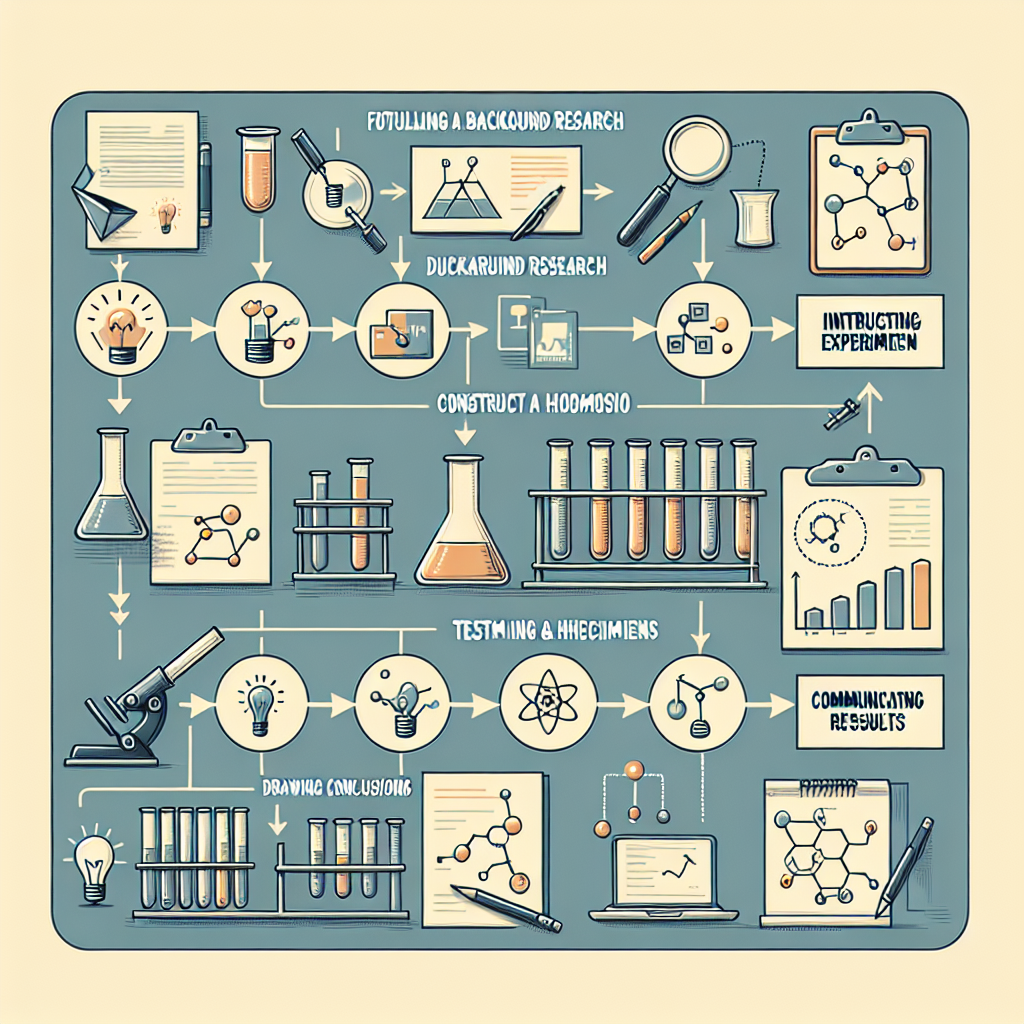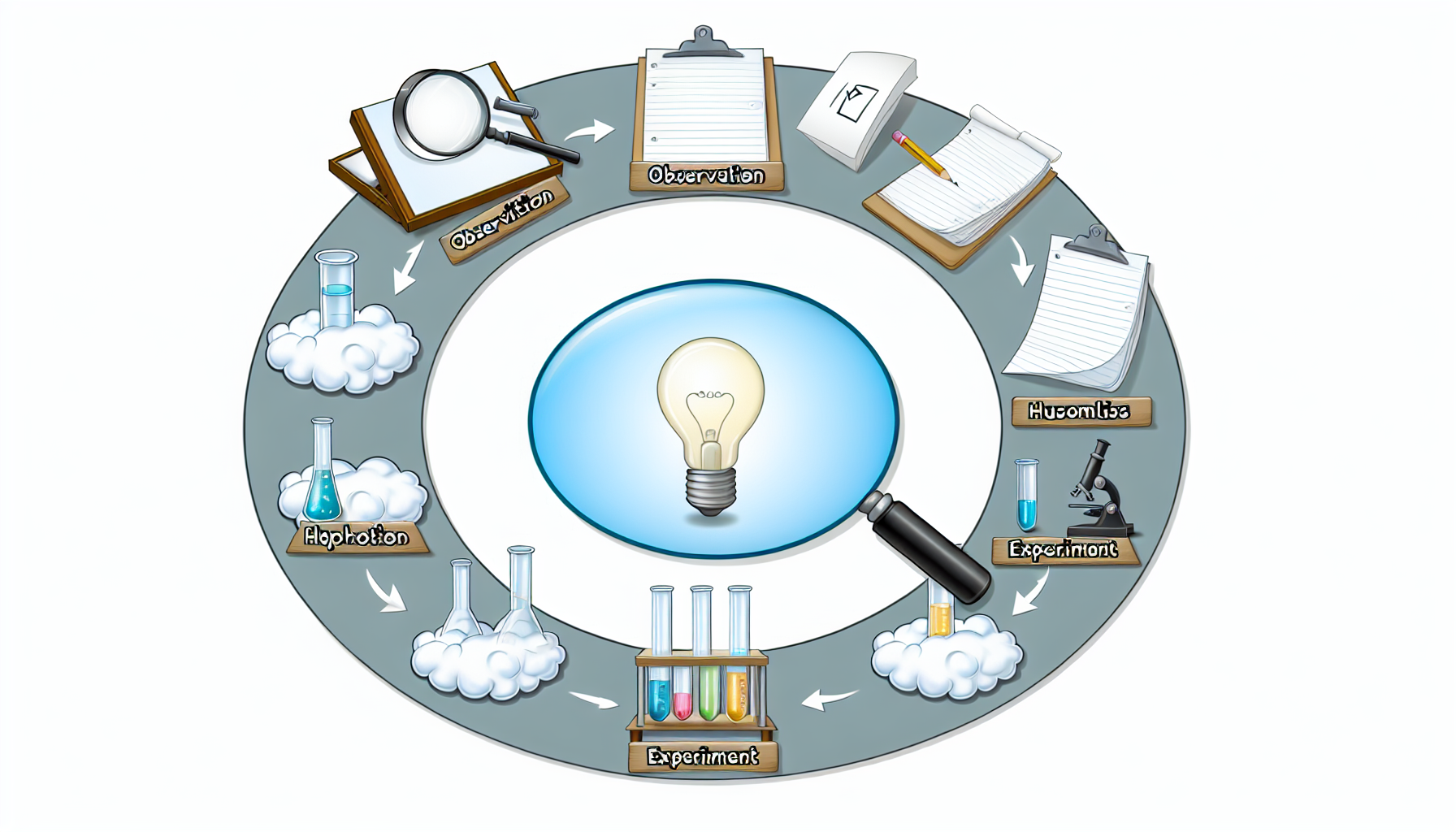Uncover the principles of scientific method in conducting research effectively. Explore steps involving experiments, hypothesis testing, data analysis, and peer review.

The scientific method is a structured approach to inquiry that has played a pivotal role in the development of knowledge across disciplines such as biology, psychology, and physics. Defined by a series of steps aimed at investigating phenomena, gathering new information, and correcting or integrating past knowledge, it forms the foundation of rigorous scientific inquiry.
This systematic process not only enhances the validity of results but also promotes reproducibility, allowing other researchers to build upon existing findings.

Historically, the roots of the scientific method can be traced back to ancient philosophers who sought to understand the natural world through observation and reason. Notable figures such as Aristotle contributed significantly to early scientific thought, emphasizing the role of empirical evidence. However, it was during the Renaissance period that the method evolved into a more formalized approach, bolstered by the work of scientists like Galileo and Bacon, who advocated for experimental observation over mere speculation.
In the contemporary landscape, the scientific method remains a cornerstone of research in various fields. Its steps typically include forming a hypothesis based on initial observations, conducting controlled experiments to test that hypothesis, collecting and analyzing data, and drawing conclusions that feed back into the scientific community. This iterative process enables scientists to refine their understanding of complex phenomena, discard unfounded theories, and solidify evidence-based insights. Moreover, it fosters collaboration among researchers, as a shared methodology deepens collective knowledge and paves the way for scientific advancements.
Ultimately, the relevance of the scientific method in today’s research cannot be overstated. As we face new challenges—ranging from health crises to environmental issues—this rigorous approach will guide researchers in developing effective solutions, demonstrating its enduring importance across both academic and practical applications.
Making observations is a cornerstone of the scientific method, serving as the initial step that catalyzes the research process. This phase is critical because it involves gathering information from the environment, providing the basis upon which researchers can formulate relevant questions. Observations can be categorized into two primary types: qualitative and quantitative. Qualitative observations are descriptive and often involve characteristics that can be observed but not measured. For instance, noting the color of a flower or the texture of a surface are qualitative observations. Conversely, quantitative observations involve measurable data, such as the number of petals on a flower or the temperature of a substance.
The skill of observation is not innate; it requires practice and diligence. Effective researchers cultivate their observational abilities through a systematic approach, enabling them to notice patterns, anomalies, or phenomena that may not be immediately apparent. This keen sense of observation often leads to the identification of gaps in existing knowledge or unexplored questions that merit further investigation. Developing a structured observational strategy can significantly enhance a researcher’s chances of discovering valuable insights.
Moreover, context plays a crucial role in making observations. Being aware of the environment, the presence of variables, and the timing of observations can influence the quality of data collected. Enhanced observational skills allow researchers to draw connections between their observations and theoretical frameworks, facilitating the generation of hypotheses that can be empirically tested. Therefore, making thorough and methodical observations is not merely an introductory step; it is fundamental in setting the stage for subsequent phases of research and inquiry.
Formulating a question is a critical step in the scientific method. This phase stems from careful observations, enabling researchers to delineate specific inquiries that can be systematically explored. A well-crafted research question is pivotal as it guides the direction of the study and determines the methodologies that will be employed. Importantly, the question should be clear, focused, and researchable, laying the groundwork for a thorough investigation.
To derive an effective research question, researchers should first reflect on their observations and identify patterns or anomalies that pique their interest. By channeling their curiosity, they can generate questions that are not only relevant but also significant within the context of their field of research. Creativity plays a vital role here; innovative questions often lead to novel insights and discoveries. For instance, rather than asking, “What causes X?” one might consider a broader question like, “How does X influence Y in various environments?” Such an approach fosters a more comprehensive exploration.
Moreover, researchers should ensure that the questions they formulate are feasible and specific enough to allow for manageable data collection and analysis. Utilizing resources such as literature reviews can also aid in refining the question, as this allows researchers to understand existing knowledge and identify gaps that their inquiry could address. Additionally, it’s beneficial to express questions in a way that reflects the anticipated relationship between variables, utilizing terms that are familiar within the scientific community to enhance clarity.
Ultimately, the formulation of a question is an iterative process that may require several revisions. Each iteration should strive to sharpen the focus and enhance the relevance of the inquiry, leading to a robust foundation for the subsequent steps in the scientific method.

Conducting thorough background research is a vital step in the scientific method as it helps researchers build a solid foundation before formulating their hypotheses. Engaging in background research enables individuals to refine their research questions, ensuring they are both relevant and actionable. By investigating existing literature within a particular field, researchers can uncover gaps in knowledge, identify leading theories, and understand the context of prior studies. This step is crucial for any effective research endeavor.
To embark on this journey, researchers should start by identifying key terms and concepts related to their topic of interest. Utilizing academic databases such as PubMed, Google Scholar, and JSTOR can facilitate a broad search for scholarly articles, books, and conference papers. Additionally, leveraging library resources, including academic journals and institutional repositories, can provide access to comprehensive literature. Researchers should focus on peer-reviewed sources, as these materials are rigorously evaluated by experts, ensuring credibility and reliability.
As researchers gather information, it is essential to critically analyze the sources to determine their pertinence and authority. This includes considering the author’s credentials, publication year, and the methods used in the studies. Synthesizing knowledge from various credible sources allows researchers to draw informed conclusions about what is already established in their field, further shaping their research focus.
Moreover, keeping detailed notes during the background research process is recommended to aid future reference and the development of a literature review. This systematic approach not only enriches the researcher’s understanding of their subject matter but also provides the groundwork for developing a robust and impactful research project. Effective background research ultimately strengthens the quality and relevance of the scientific inquiry undertaken.
Once the research question has been articulated and background research has been conducted, the next step in the scientific method is to formulate a hypothesis. A hypothesis is a specific, testable prediction about the expected outcome of an experiment, which serves as a foundation for further investigation. It is essential that this hypothesis is constructed based on the information gathered during previous steps to ensure it is both relevant and grounded in existing knowledge.
A good hypothesis possesses several key characteristics. Firstly, it should be clear and concise, allowing for easy understanding and communication. Furthermore, it must be specific enough to suggest the variables involved and their expected relationship. The hypothesis ought to be inherently testable, meaning that it can be supported or rejected through experimental data collection. This essence of testability is crucial for the integrity of the scientific method, as it allows researchers to draw meaningful conclusions.
For instance, instead of making a vague statement like “plants grow better,” a more precise hypothesis would be “increased sunlight exposure will lead to higher growth rates in tomato plants compared to those receiving minimal sunlight.” This formulation clearly specifies the independent variable (sunlight exposure) and the dependent variable (growth rates of tomato plants), making it easier to design an experiment around it.
When drafting a hypothesis, it is advantageous to utilize an “if-then” format. This structure links the independent and dependent variables in a straightforward manner. For example, “If tomato plants are exposed to increased sunlight, then their growth rates will be higher than those of tomato plants in shaded conditions.” This statement not only defines the variables but also indicates the anticipated outcome, effectively guiding the experimental design. With a well-constructed hypothesis in hand, researchers can proceed to design experiments that will test their predictions and yield results that enhance the broader body of scientific knowledge.
Designing and conducting experiments is a critical phase in the scientific method, facilitating the test of the hypothesis formed earlier in the research process. A robust experimental design provides clarity and reliability, ensuring that the outcomes can effectively address the research question at hand. One of the fundamental components of an experiment is the establishment of control groups. Control groups serve as a benchmark against which the experimental group can be compared. This comparison allows researchers to determine the effect of the independent variable on the dependent variable accurately.
In addition to control groups, it is essential to identify both independent and dependent variables. The independent variable is the factor that is manipulated or changed by the researcher, while the dependent variable is what is measured or observed in response to the manipulation. Having a clear understanding of these variables is crucial for establishing a cause-and-effect relationship, which is the cornerstone of any scientific inquiry.
Sample size also plays a pivotal role in experimental design. A larger sample size can increase the reliability of results, as it helps account for variability and reduces the likelihood of random error. However, researchers must balance practicality with statistical power, as excessively large sample sizes can introduce logistical challenges. Thus, it is essential to determine an appropriate sample size based on the specific requirements of the research.
Finally, ensuring the reliability and validity of the experiment’s outcomes is imperative. Reliability refers to the consistency of results over repeated trials, while validity pertains to how well the experiment measures what it is supposed to measure. This can often be achieved through the use of standardized procedures, randomization, and replication. By meticulously planning and executing an experiment, researchers can contribute valuable insights to their field of study, moving a step closer to understanding the complexities of the natural world.
Data collection is a pivotal step in the scientific method, serving as the foundation for deriving valid conclusions and insights. This process involves gathering information systematically, utilizing a range of methodologies that fall under qualitative and quantitative approaches. Each approach serves different types of research questions and can be selected based on the objectives of the study and the nature of the information sought.
Quantitative data collection typically involves numerical data that can be analyzed statistically. Common methods include structured surveys, experiments, and observational studies that yield measurable results. Researchers often utilize tools such as online survey platforms or statistical software to facilitate accurate data gathering and analysis. It is essential to ensure the questions or metrics used in quantitative research are clear and concise to minimize biases and inaccuracies.
On the other hand, qualitative data collection focuses on understanding phenomena through detailed descriptions and subjective interpretations. Techniques such as interviews, focus groups, and open-ended surveys are commonplace. These methods allow researchers to explore ideas and emotions that drive behaviors, providing a depth of understanding not achievable through quantitative measures alone. Audio or video recording tools can enhance the accuracy of qualitative data recording, ensuring that nuances in responses are captured faithfully.
Regardless of the approach taken, maintaining data accuracy is critically important. Researchers should double-check data entries and clarify any ambiguities promptly. Furthermore, ethical considerations cannot be overlooked in the data collection process. Ensuring informed consent, respecting participant anonymity, and being transparent about data usage is imperative to safeguard the rights of research subjects and foster trust between researchers and participants. Implementing stringent ethical standards not only strengthens the integrity of the research but also upholds the fundamental principles of respect and dignity in all scientific inquiries.

Once the data has been collected in a research study, the next crucial phase involves analyzing and interpreting the results. Various data analysis techniques can be employed depending on the nature of the data and the research objectives. For quantitative data, statistical analysis is paramount. This involves employing software tools or statistical tests to determine patterns, relationships, and significances within the data. Common techniques include descriptive statistics, inferential statistics, regression analysis, and hypothesis testing. Each of these methods offers valuable insights regarding the data collected and facilitates informed conclusions.
In addition to statistical analysis, the visual representation of data plays an essential role in conveying complex information. Techniques such as graphs, charts, and tables can help to illustrate findings clearly and effectively. By transforming raw data into visual formats, researchers can enhance understanding and facilitate further interpretation. Visualization can also aid in identifying trends and anomalies that may not be as evident through numerical analysis alone.
However, while analyzing and interpreting results, it is crucial to recognize the potential impact of biases on outcomes. Bias can stem from various sources, including sample selection, data collection methods, and even personal interpretations. Researchers must remain vigilant, implementing strategies to minimize bias, such as blinding or randomization. Additionally, reflecting on the context and limitations of the data is vital when drawing conclusions. Understanding that results are part of a broader inquiry helps in maintaining objectivity and informs future research directions.
By carefully analyzing data and remaining aware of biases, researchers can draw meaningful conclusions that contribute to the field’s knowledge base and offer practical applications of their findings. This process is not only essential for validating the initial hypothesis but also for exploring new avenues of inquiry that may arise as a result of the research conducted.
Upon completing the analysis of data gathered during research, the next crucial step involves drawing conclusions based on the evidence. This phase requires interpreting the results in relation to the original hypothesis or research question, allowing researchers to ascertain whether their initial assumptions hold true. Conclusions should be clearly articulated, directly addressing the research question and supporting the findings with data, ensuring that interpretations are both logical and evidence-based.
To communicate findings effectively, researchers typically structure their work into a scientific paper. A well-organized paper will include distinct sections such as an abstract, introduction, methodology, results, discussion, and conclusion. Each section serves a specific purpose; for instance, the abstract provides a concise summary of the entire study, while the introduction outlines the research background and objectives. In the results section, researchers should present their findings objectively, often utilizing tables, charts, and graphs to enhance clarity and facilitate understanding.
Moreover, discussing the implications of the findings is paramount. Researchers must highlight how their results contribute to the existing body of knowledge, including practical applications, policy implications, or potential advancements in the field. Additionally, acknowledging the limitations of the research is crucial as it provides context and assists in setting realistic expectations regarding the applicability of the results. Limitations may arise from factors such as sample size, methodological constraints, or external variables that might influence the outcomes.
In conclusion, the processes of drawing conclusions and communicating findings are vital elements of the scientific method. By structuring their research effectively and transparently discussing results, implications, and limitations, researchers contribute to the integrity and advancement of scientific knowledge, fostering a deeper understanding of the subject matter. This systematic approach not only aids in validating the research but also enhances the overall impact on the scientific community and society at large.
The scientific method serves as a foundational framework for conducting rigorous research and fostering critical thinking skills. Its systematic approach enables researchers to formulate hypotheses, conduct experiments, and draw evidence-based conclusions, ultimately leading to advancements across various fields. By adhering to the scientific method, individuals can not only enhance their problem-solving capabilities but also contribute to a culture of inquiry and innovation.
Continuous learning is a crucial aspect of the research process. As new findings emerge and technologies evolve, it is essential for researchers to remain adaptable and open to modifying their methodologies. Engaging with peer reviews, attending scholarly conferences, and collaborating with others in the same field can provide valuable insights and constructive feedback. This exchange of ideas often leads to the refinement of existing theories and the formulation of new questions that drive further inquiry.
Moreover, conducting follow-up studies based on previous research can yield significant benefits. Such studies allow for the exploration of unanswered questions or the testing of different variables under altered conditions. Whether through replication studies or extension of existing projects, building upon past findings strengthens the overall reliability and validity of the research process.
To optimize research outcomes, researchers should carefully consider the feedback received from peer evaluations and other forms of critique. Utilizing this feedback to inform future studies can enhance methodologies and ensure that the research is aligned with the highest standards of scientific inquiry. In integrating these suggestions and maintaining a commitment to the scientific method, researchers are better equipped to tackle complex challenges and generate knowledge that is both impactful and enduring.
Find Scholarships Offered by Countries Worldwide for Your Academic Goals.
Chose where you want to study, and we will let you know with more updates.